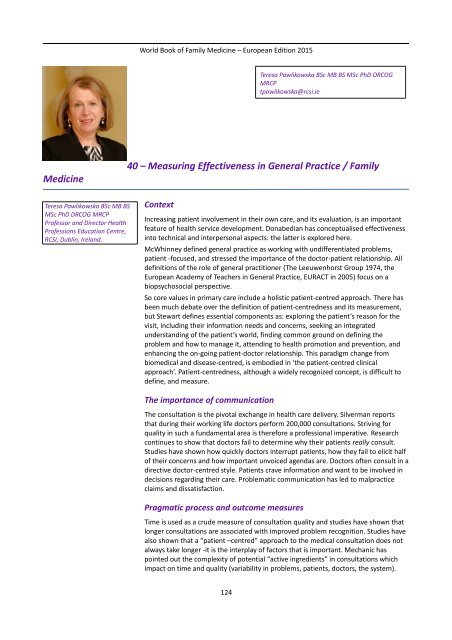Family Medicine
World Book 2015
World Book 2015
You also want an ePaper? Increase the reach of your titles
YUMPU automatically turns print PDFs into web optimized ePapers that Google loves.
World Book of <strong>Family</strong> <strong>Medicine</strong> – European Edition 2015<br />
Teresa Pawlikowska BSc MB BS MSc PhD DRCOG<br />
MRCP<br />
tpawlikowska@rcsi.ie<br />
<strong>Medicine</strong><br />
40 – Measuring Effectiveness in General Practice / <strong>Family</strong><br />
Teresa Pawlikowska BSc MB BS<br />
MSc PhD DRCOG MRCP<br />
Professor and Director Health<br />
Professions Education Centre,<br />
RCSI, Dublin, Ireland.<br />
Context<br />
Increasing patient involvement in their own care, and its evaluation, is an important<br />
feature of health service development. Donabedian has conceptualised effectiveness<br />
into technical and interpersonal aspects: the latter is explored here.<br />
McWhinney defined general practice as working with undifferentiated problems,<br />
patient -focused, and stressed the importance of the doctor-patient relationship. All<br />
definitions of the role of general practitioner (The Leeuwenhorst Group 1974, the<br />
European Academy of Teachers in General Practice, EURACT in 2005) focus on a<br />
biopsychosocial perspective.<br />
So core values in primary care include a holistic patient-centred approach. There has<br />
been much debate over the definition of patient-centredness and its measurement,<br />
but Stewart defines essential components as: exploring the patient’s reason for the<br />
visit, including their information needs and concerns, seeking an integrated<br />
understanding of the patient’s world, finding common ground on defining the<br />
problem and how to manage it, attending to health promotion and prevention, and<br />
enhancing the on-going patient-doctor relationship. This paradigm change from<br />
biomedical and disease-centred, is embodied in ‘the patient-centred clinical<br />
approach’. Patient-centredness, although a widely recognized concept, is difficult to<br />
define, and measure.<br />
The importance of communication<br />
The consultation is the pivotal exchange in health care delivery. Silverman reports<br />
that during their working life doctors perform 200,000 consultations. Striving for<br />
quality in such a fundamental area is therefore a professional imperative. Research<br />
continues to show that doctors fail to determine why their patients really consult.<br />
Studies have shown how quickly doctors interrupt patients, how they fail to elicit half<br />
of their concerns and how important unvoiced agendas are. Doctors often consult in a<br />
directive doctor-centred style. Patients crave information and want to be involved in<br />
decisions regarding their care. Problematic communication has led to malpractice<br />
claims and dissatisfaction.<br />
Pragmatic process and outcome measures<br />
Time is used as a crude measure of consultation quality and studies have shown that<br />
longer consultations are associated with improved problem recognition. Studies have<br />
also shown that a “patient –centred” approach to the medical consultation does not<br />
always take longer -it is the interplay of factors that is important. Mechanic has<br />
pointed out the complexity of potential “active ingredients” in consultations which<br />
impact on time and quality (variability in problems, patients, doctors, the system).<br />
124


